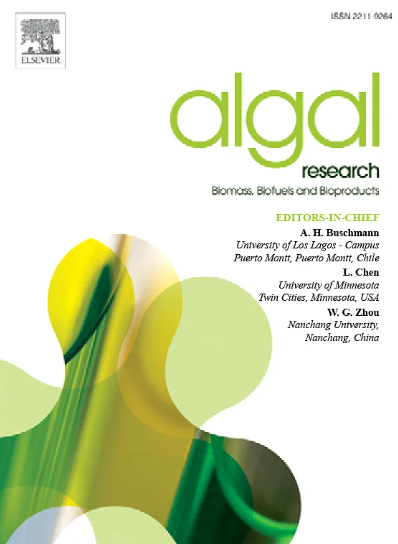碱性磷酸酶偶联的高亲和磷酸盐转运蛋白参与了yezoensis对低磷胁迫的响应
IF 4.5
2区 生物学
Q1 BIOTECHNOLOGY & APPLIED MICROBIOLOGY
Algal Research-Biomass Biofuels and Bioproducts
Pub Date : 2025-05-19
DOI:10.1016/j.algal.2025.104101
引用次数: 0
摘要
磷酸盐(Pi)经常成为海洋中的限制性营养物质,特别是在大型藻类养殖区。更重要的是,叶红杉种植密度的不断增加加剧了缺磷问题。本研究采用转录组分析方法。在低pi条件下,yezoensis幼苗的碱性磷酸酶PyALP基因显著上调。通过加权基因共表达网络分析(Weighted Gene Co-expression Network Analysis, WGCNA)和Pearson相关性分析,Pi转运蛋白基因PyPHO89和6个转录因子与PyALP共表达。生物信息学预测表明PyALP属于PhoA型酶。然而,没有检测到糖基磷脂酰肌醇(GPI)和锚定n端甘氨酸的分子结构,这表明PyALP仅限于细胞壁和质膜之间的微环境,在那里它水解溶解的有机磷(DOP)。预测PyPHO89是无机磷吸收的高亲和同调体。启动子分析在PyALP和PyPHO89中均发现Myb结合位点。在筛选的潜在转录因子基因中,只有Py08914具有保守的SHLQKYR基序和富含谷氨酰胺的c端序列,这是典型的Pi缺陷应答转录因子的特征。定量RT-PCR结果显示,饥饿6 h后,PyALP和PyPHO89表达上调,Py08914表达在饥饿前2 ~ 4 h达到高峰。这表明DOP的水解和磷的吸收是由Myb转录因子共同调节的。PyALP活性随着pi饥饿的增加而增加,磷酸酯和膦酸盐都能以相似的效率利用。这是首次报道Py中pi缺乏反应机制。yezoensis。本文章由计算机程序翻译,如有差异,请以英文原文为准。
Alkaline phosphatase-coupled high affinity phosphate transporters were involved in low phosphorus stress responding in Pyropia yezoensis
Phosphate (Pi) often becomes a limiting nutrient in oceans, particularly in macroalgae aquaculture areas. More importantly, the continuous increase of Pyropia yezoensis cultivation density has exacerbated Pi deficiency issues. This study used transcriptome analysis of Py. yezoensis seedlings under low-Pi conditions and identified the gene PyALP, an alkaline phosphatase, which was significantly upregulated. Through Weighted Gene Co-expression Network Analysis (WGCNA) and Pearson correlation, PyPHO89, a Pi transporter gene, and six transcription factors were co-expressed with PyALP. Bioinformatics predictions indicated that PyALP belongs to a PhoA type enzyme. However, the molecular structures of the glycosylphosphatidylinositol (GPI) and anchor the N-terminal glycine were not detected, suggesting that PyALP is confined to the microenvironment between the cell wall and plasma membrane, where it hydrolyzes dissolved organic phosphorus (DOP). PyPHO89 was predicted to be a high-affinity symporter for inorganic phosphorus uptake. Promoter analysis revealed Myb binding sites in both PyALP and PyPHO89. Among the screened potential transcription factor genes, only Py08914 possessed a conserved SHLQKYR motif and a glutamine-rich C-terminal sequence, which are characteristic of a typical Pi deficiency-responsive transcription factor. Quantitative RT-PCR showed upregulation of PyALP and PyPHO89 after 6 h of Pi-starvation, and expression of Py08914 peaked in the first 2–4 h of starvation. This implies that the hydrolysis of DOP and uptake of phosphorus are co-regulated by the Myb transcription factor. PyALP activity increased with Pi-starvation and both phosphoesters and phosphonates could be used with similar efficiency. This is the first report regarding the Pi-deficiency response mechanism in Py. yezoensis.
求助全文
通过发布文献求助,成功后即可免费获取论文全文。
去求助
来源期刊

Algal Research-Biomass Biofuels and Bioproducts
BIOTECHNOLOGY & APPLIED MICROBIOLOGY-
CiteScore
9.40
自引率
7.80%
发文量
332
期刊介绍:
Algal Research is an international phycology journal covering all areas of emerging technologies in algae biology, biomass production, cultivation, harvesting, extraction, bioproducts, biorefinery, engineering, and econometrics. Algae is defined to include cyanobacteria, microalgae, and protists and symbionts of interest in biotechnology. The journal publishes original research and reviews for the following scope: algal biology, including but not exclusive to: phylogeny, biodiversity, molecular traits, metabolic regulation, and genetic engineering, algal cultivation, e.g. phototrophic systems, heterotrophic systems, and mixotrophic systems, algal harvesting and extraction systems, biotechnology to convert algal biomass and components into biofuels and bioproducts, e.g., nutraceuticals, pharmaceuticals, animal feed, plastics, etc. algal products and their economic assessment
 求助内容:
求助内容: 应助结果提醒方式:
应助结果提醒方式:


